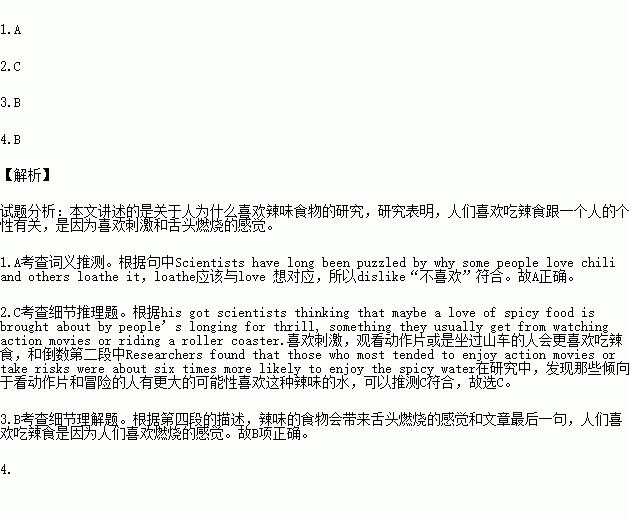题目内容
What’s your opinion on spicy food? Some people cannot handle even the smallest amount of chili(辣椒) in their dinner while others can’t get enough of it.
Scientists have long been puzzled by why some people love chili and others loathe it. Plenty of research has been done on the subject, dating back to as far as the 1970s. Previous results showed that a love of chili is related to childhood experiences, and cultural influences affect our taste buds, too. But the latest study has found that a person’s love of spicy food may be linked to his or her personality more than anything else, CBC News reported.
“We have always assumed that liking drives intake---we eat what we like and we like what we eat. But no one has actually directly bothered to connect these personality traits with intake of chili peppers,” said Professor John Hayes from Pennsylvania State University, who led the study.
But before you look at the study, you should first know that “spicy” is not a taste, unlike sour, sweet, bitter and salty. It is, in fact, a burning sensation that you feel on the surface of your tongue. This got scientists thinking that maybe a love of spicy food is brought about by people’s longing for thrill, something they usually get from watching action movies or riding a roller coaster.
In the study, 97 participants, both male and female, were asked to fill out questionnaires about certain traits of their personality, for example. Whether they like new experiences or tend to avoid risks. They were then given cups of water with capsaicin(辣椒素), the plant chemical that makes chili burn, mixed into them.
By comparing the answers to questionnaires and what participants said they felt about the spicy water. Researchers found that those who most tended to enjoy action movies or take risks were about six times more likely to enjoy the spicy water.
Interestingly, we used to believe that the reason some people can withstand spicy food is that their tongue have become less sensitive to it. However, this latest study has found otherwise. It’s not that it doesn’t burn as badly, it’s that you actually learn to like the burn,” Hayes explained.
1.What’s the meaning of the underlined word “loathe” in the second paragraph?
A. dislike B. fear
C. put up with D. adapt to
2.What did Professor John Hayes and his team discover from their study?
A. what we eat actually helps to develop our personalities.
B. Males are more likely to enjoy spicy food than females.
C. Those trying to avoid risks tend to be less interested in spicy food.
D. People are wrong to treat spicy as a kind of taste rather than a feeling.
3.Why do some people like spicy food according to the recent study?
A. Because their taste buds have become less sensitive.
B. Because they love the burning sensation.
C. Because they want to challenge themselves.
D. Because the more they try spicy food, the less it burns.
4.What’s the main idea of the passage?
A. What he or she likes to eat mainly decides on his or her personality.
B. That a person enjoys spicy food depends largely on the personality.
C. His or her childhood experiences decide on his or her personality.
D. His or her cultural background decides on his or her personality.

